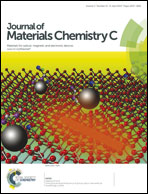Schiff base derivatives containing heterocycles with aggregation-induced emission and recognition ability†
Abstract
Three new Schiff base derivatives possessing vagarious blue aggregation-induced emission (AIE) characteristics in tetrahydrofuran (THF)–water were synthesized. Their photophysical properties in solution, aqueous suspension, film and crystalline states, along with their relationships, were comparatively investigated. The crystallographic data for dye 1 and dye 3 indicated that the existence of multiple intermolecular hydrogen bonding interactions restricted intramolecular vibration and rotation. Moreover, the sizes and growth processes of particles with different water fractions were studied using a scanning electron microscope (SEM) and dynamic light scattering (DLS). The results showed that the small homogeneous particles, assembled in an ordered fashion with appropriate water contents, exhibited distinct AIE behavior. Moreover, in a THF–H2O (4 : 1, v/v) solution of HEPES (20 mM) buffer, dye 2 showed fluorescence turn-on sensing towards Cr3+ and Al3+via chelation enhanced fluorescence (CHEF). The 2 : 1 stoichiometries of the sensor complexes (dye 2–Cr3+ and dye 2–Al3+) were calculated from Job plots based on fluorescence titrations.


 Please wait while we load your content...
Please wait while we load your content...